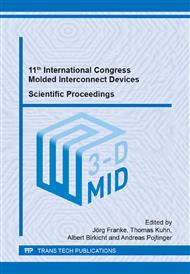p.49
p.57
p.63
p.69
p.75
p.83
p.89
p.97
p.107
Experimental Investigation of Laser Sintering of Conductive Adhesive for Functional Prototypes Produced by Embedding Stereolithography
Abstract:
Embedding stereolithography (eSLA) is an additive, hybrid process, which provides a flexible production of 3D components and the ability to integrate electrical and optical conductive structures and functional components within parts. However, the embedding of conductive circuits in stereolithography (SLA) parts assumes usage of process technologies, which enables their direct integration of conductive circuits during the layer-wise building process. In this context, a promising method for in-situ generation of conductive circuits is dispensing of conductive adhesive on the current surface of the SLA part and its subsequent sintering. In this paper, the laser sintering (λ = 355 nm) of conductive adhesive mainly consisting of silver nanoparticles is investigated. The work intends to evaluate the curing behavior of the conductive adhesive, the beam-matter-interactions and the thermal damage of the SLA substrate. The investigations revealed a fast and flexible laser sintering process for the generation of conductive circuits with sufficient electrical conductivity and sufficient current capacity load. In this context, a characterization of the conductive structures is done by measuring their electrical resistance and their potential current capacity load.
Info:
Periodical:
Pages:
75-81
Citation:
Online since:
September 2014
Authors:
Price:
Сopyright:
© 2014 Trans Tech Publications Ltd. All Rights Reserved
Share:
Citation:


